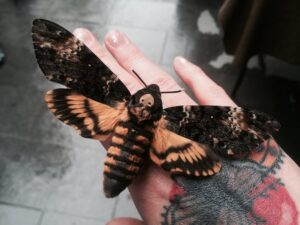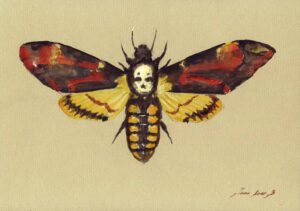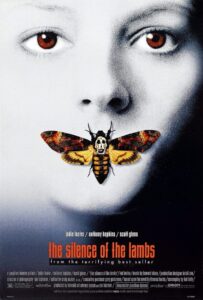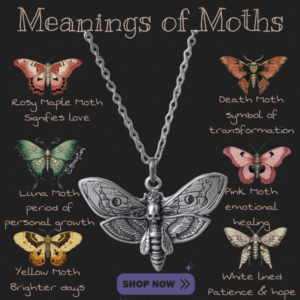The death moth, also known as the death’s-head hawkmoth, is a captivating and enigmatic creature that has intrigued mystics and seekers of the occult for centuries. With its eerie skull-like marking on its thorax, this moth has left an indelible mark on cultures worldwide. In this mystical journey, we will delve into the multifaceted symbolism of the death moth, unearthing its connections to death, transformation, and the mysteries of the afterlife.
The Death Moth’s Ominous Presence
Native to Europe, Africa, and Asia, the death moth has ventured into North America, making its presence known far and wide. Its striking appearance, adorned with a macabre skull-like image, has forever linked it to notions of death and foreboding. When this moth crosses your path, it is often seen as a portent of doom, a harbinger of the unknown.
The Death Moth’s Hidden Message

Yet, within the darkness of its symbolism, the death moth carries a profound message of transformation and rebirth. Like the caterpillar’s metamorphosis into a moth, this creature signifies the transition from one existence to another. It whispers secrets of change and new beginnings, urging us to embrace the ever-shifting tides of our lives.
The Death Moth and Mythology: A Bewitching Connection
This cryptic moth makes appearances in various cultures and mythologies worldwide, weaving its spellbinding narrative into the tapestry of the mystical world. In Europe, it dances with witches and witchcraft, a companion to the enigmatic forces of the occult. In the Caribbean, the sight of a death moth sends shivers down spines, signifying impending doom and the spectral realm’s touch.
A Messenger from the Spirit World
For Native American cultures, this moth embodies a messenger from the spirit world. In certain tribes, it is thought to facilitate communication with departed loved ones, bridging the chasm between the living and the dead. It carries messages from realms beyond our mortal perception, a mystical emissary guiding us through the twilight of existence.
What is the Japanese mythology of moths?
In Japanese mythology, moths are often associated with death and the spirit world. This is likely due to their nocturnal habits and their association with darkness. However, moths are also seen as symbols of transformation and rebirth, as they undergo a dramatic metamorphosis during their life cycle.

One of the most famous moth yōkai (supernatural creature) in Japanese folklore is the shinchū. Shinchū are giant moth gods that are said to live in remote mountains and forests. They are typically depicted as having saucer-like eyes, a gaping mouth full of sharp teeth, eight legs, enormous wings, and a long stinger protruding from the rear of their segmented abdomen.
Another notable moth yōkai is the gaoga (or gagao). Gaoga are said to be the souls of people who have died in battle. They appear as large, moth-like creatures with the faces of human warriors. Gaoga are often depicted as carrying swords or other weapons, and they are said to be fiercely protective of their territory.
Moths also appear in Japanese mythology in more positive roles. For example, the white moth is often seen as a messenger from the gods. It is also said that the souls of the dead can sometimes appear in the form of white moths.
The Death Moth in Popular Culture
In the 1991 psychological horror film “The Silence of the Lambs,” the Death’s-head moth plays a recurring role. It first appears during FBI agent Clarice Starling’s interview with Dr. Hannibal Lecter, a brilliant but cannibalistic psychiatrist. Lecter, intrigued by the moth, explains its symbolism of transformation and death. Later, the moth is seen in Lecter’s cell, resting on a skull, symbolizing his lack of fear for death as part of life’s natural cycle.

The Death’s-head moth resurfaces when Starling confronts Buffalo Bill, a serial killer who skins his victims for a gruesome human suit. Bill wears a Death’s-head moth mask, claiming he is “becoming” the moth, symbolizing his obsession with death and transformation.
Unlocking Spiritual Wisdom
For the spiritually inclined, the death moth serves as a powerful symbol, encapsulating a range of meanings:
Transformation and Rebirth
The death moth reminds us that death is not the terminus but a threshold to a new beginning. It beckons us to embrace change with open arms.
Change and New Beginnings
In the graceful flutter of the death moth’s wings, we find solace in the inevitability of change. It is a symbol of the ceaseless evolution and growth inherent in our lives.
The Duality of Life and Death
Within the delicate confines of its wings, the death moth reveals the profound interconnectedness of life and death. They are not opposing forces but harmonious components of the natural order, inextricably bound.
Embrace the Mystical Wisdom of the Death Moth
As the death moth flits into your awareness, take a moment to decipher its cryptic message. What does it whisper to your soul? Does it beckon you towards transformation, or does it evoke thoughts of the eternal dance between life and death? The death moth is a paradoxical symbol, both ominous and enlightening, inviting you to explore the mystical depths of existence.

